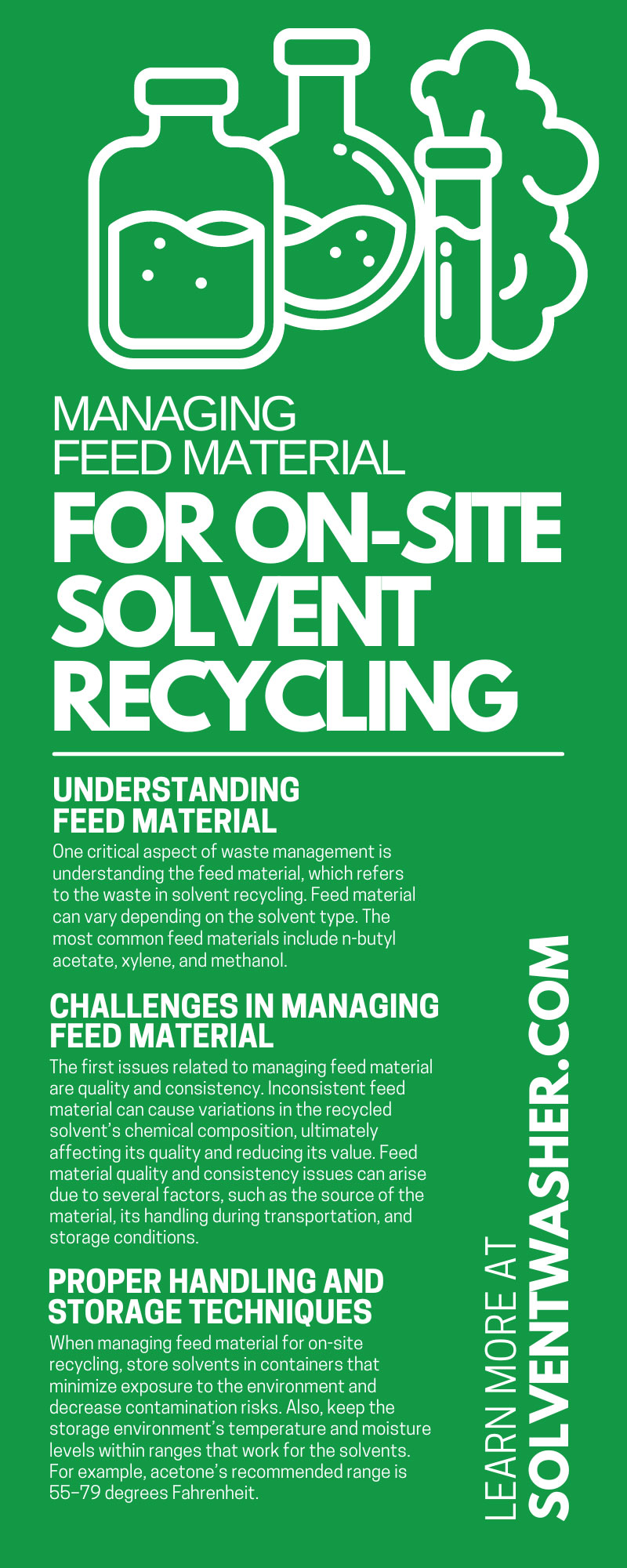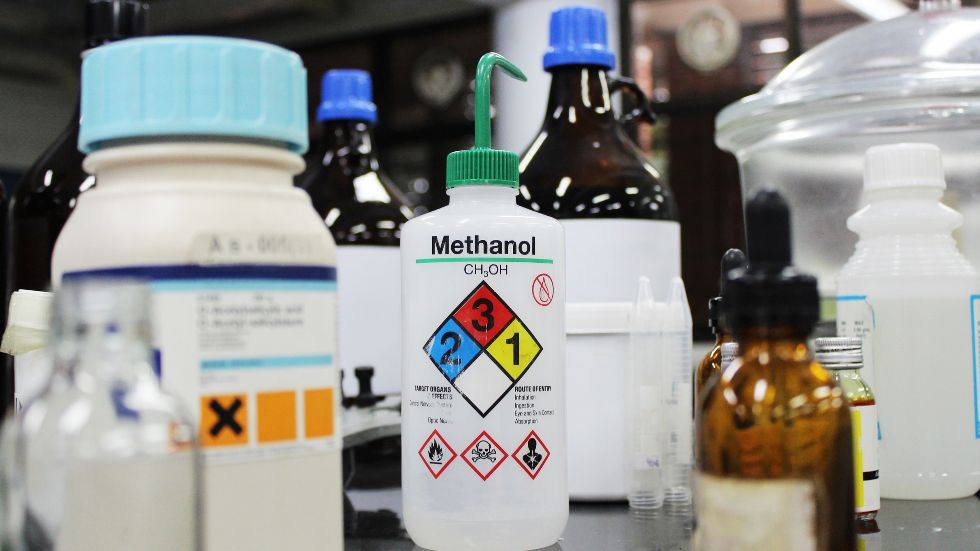Solvent recycling is an effective waste management strategy that reduces the environmental impact of solvent waste that results from industrial processes. The recovered solvents can reduce costs for industries that generate a lot of solvent waste, such as pharmaceuticals, automotive, and electronics. Managing feed material can ensure smooth and efficient recycling. Here’s how to manage feed material for on-site solvent recycling.
Understanding Feed Material
One critical aspect of waste management is understanding the feed material, which refers to the waste in solvent recycling. Feed material can vary depending on the solvent type. The most common feed materials include n-butyl acetate, xylene, and methanol.
Note that different feed materials contain varying chemical compositions and impurities. Consequently, they may exhibit different properties that can influence the solvent recycling process. For instance, some feed materials are more viscous than others, and quite a few feed materials could contain water.
These properties may require pre-treatment procedures before you can recycle the solvent. Having a profound understanding of the chemical and physical properties of the feed material is critical for establishing the best solvent recycling process.
The Importance of Knowing Feed Material Characteristics
By knowing the characteristics of the feed material, such as its reactivity, solubility, boiling point, and viscosity, you can determine the most suitable solvent and recycling method. For instance, if the feed material is highly reactive, it may require a solvent with low reactivity to prevent unwanted side reactions. Similarly, if the feed material has a high boiling point, a solvent with a matching or higher boiling point is necessary for separation during distillation.
Consider the solubility of the feed material in the chosen solvent. A solvent that can dissolve the target compounds will ensure maximum recovery during recycling. Furthermore, the feed material’s viscosity can affect the recycling process. Highly viscous substances may require additional agitation or mixing to facilitate solvent-material interaction.
By analyzing the chemical and physical properties of the feed material, you can optimize the solvent recycling process and minimize waste.
Challenges in Managing Feed Material
The first issues related to managing feed material are quality and consistency. Inconsistent feed material can cause variations in the recycled solvent’s chemical composition, ultimately affecting its quality and reducing its value. Feed material quality and consistency issues can arise due to several factors, such as the source of the material, its handling during transportation, and storage conditions.
For example, moisture content and temperature fluctuations during transportation can affect the quality of the feed material. Similarly, the source of the material can also impact its quality. When the feed comes from different sources, variations in the chemical composition can affect the efficiency of the distillation process.
Impact of Impurities and Contaminants
Impurities and contaminants in the feed material can affect the efficiency of the solvent recycling process. Contaminants can prevent the separation of the solvent from the feed material and result in poor-quality recycled solvents.
Common sources of impurities include rust, dirt, grease, oil, and other particles that accumulate in the stock. They can cause fouling in the distillation equipment and lower recovery yields. Moreover, some impurities are tough to remove, and their presence can increase the operational costs of the recycling process because the equipment may require more frequent maintenance and cleaning.
Proper Handling and Storage Techniques
Maintaining the quality and consistency of feed materials in solvent recycling relies on safe storage and handling techniques. Contamination can occur when transporting and storing feed materials, negatively impacting the quality of the recycled solvent. It’s important to adhere to these handling protocols for feed materials:
When managing feed material for on-site recycling, store solvents in containers that minimize exposure to the environment and decrease contamination risks. Also, keep the storage environment’s temperature and moisture levels within ranges that work for the solvents. For example, acetone’s recommended range is 55–79 degrees Fahrenheit.
You should also implement appropriate storage and handling procedures, such as dedicating storage areas to prevent cross-contamination of different feed materials. Minimize contamination risks by using specialized equipment for handling and transporting feed materials. Finally, clean this equipment rigorously and provide personal protective equipment (PPE) to workers for their safety.
Best Practices for Feed Material Management
Effective feed material management is crucial for optimal solvent recycling. Here are a few practices you can follow at your business.
Selecting High-Quality Feed Material
Selecting high-quality feed material facilitates solvent recycling. The process begins with identifying a reliable supplier who can provide high-quality feed material.
Additional measures to take include verifying the material’s quality and consistency and testing for impurities or foreign matter that may impact the recycled solvent’s quality. Perform regular quality testing to maintain process efficiency.
Furthermore, assessing feed material compatibility with the recycling process is essential. Using an incompatible feed material can adversely affect the process. For example, it’s best to use a paint solvent recycling machine for xylene, mineral spirits, and other paint waste.
Pre-Treating the Feed Material
Sometimes, pre-treatment is necessary for solvent recycling. Filtering, distillation, and solvent extraction are effective methods for improving the quality of the feed material.
Filtering removes solid or liquid impurities from the feed material. This technique is common for chemicals and pharmaceuticals. In this process, the material passes through a filter that eliminates undesirable particles, producing a cleaner feed material for solvent recycling.
Distillation separates the components of the feed material based on their boiling points. This method is suitable for oils and fuels. During distillation, the feed material heats until it vaporizes and condenses into a smaller volume. This process can remove impurities interfering with solvent recycling, resulting in a purer feed material.
Solvent extraction involves using a chemical to extract a desired component from the feed material. This method is common for botanical extracts. The solvent dissolves the desired component, leaving behind impurities and contaminants that recycling machines can remove.
Monitoring and Testing
Monitoring and testing procedures allow you to identify changes in the quality and consistency of the feed material. Then, you can conduct a thorough audit of the solvent waste. This involves assessing the characteristics and composition of the feed material to determine its suitability for recycling. That way, you determine if you need higher-quality materials or if you should adjust the recycling process.
The Wrap Up
Managing feed material is critical for achieving successful on-site solvent recycling. With best practices for selecting, handling, and pre-treating feed material, you can maximize recovery yields, reduce costs, and minimize the environmental impact of solvent waste.


